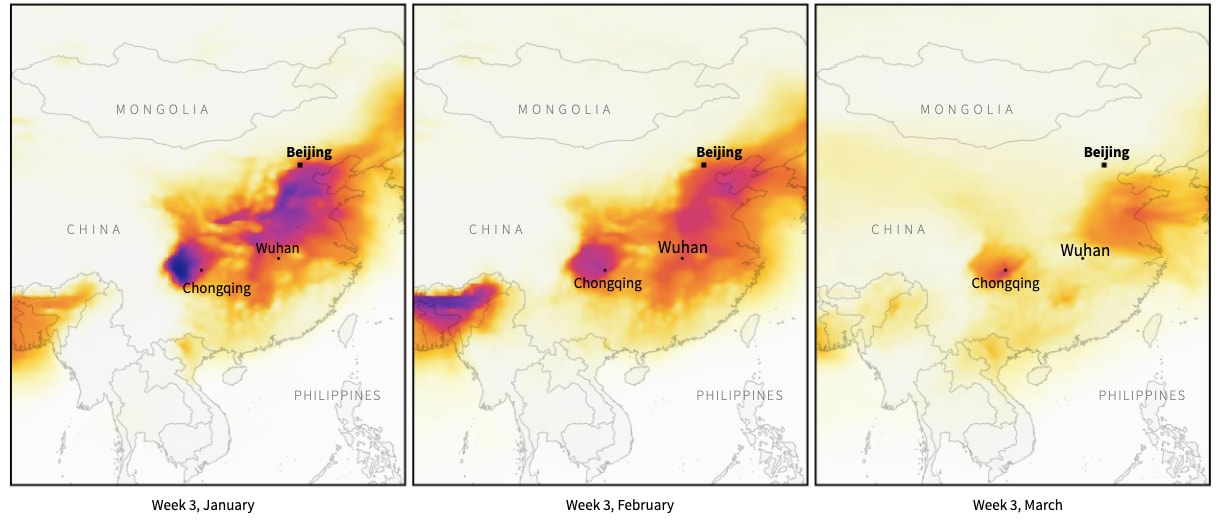Welcome Urban nomads to another issue of the nomad chronicles. In today’s post, I’ll be talking about the positive impacts in our air quality due to a decrease in tourist demand, resulting in a sluggish demand in the aviation industry.

Coronavirus have resulted in a decrease in air pollution in China
Travel restrictions of aviation activity have led to a temporarily slashing of air pollution levels around the world (Love et al., 2020). Nitrogen dioxide is produced from the emissions of airplanes due to combustion, which have been linked not only to climate change, but can also have detrimental effects on our health (Love et al., 2020). Nitric oxide has been dubbed as a toxic gas that can lead to significant inflammation of airways when exposed to concentrations of above 200 micrograms per cubic meter (Rume et al., 2020).
Air craft pollution
These particles also serve as vectors for pathogens which can help spread the virus. Furthermore, new studies have shown that in areas which high exposure to Nitric oxide, a higher fatality has been observed from the corona virus (Love et al., 2020). As such, with global air travel coming to halt, there has been significant improvements in the air quality as more people are staying at home and not flying. WHO has estimated that over 4.2 million people are killed by outdoor pollution, but as aviation ceases, this change have saved more than 50000 in china alone (Rume et al., 2020).

Improvements in Air quality during the lock down, where flights have been drastically reduced
Furthermore, with the mass groundings of flights caused by the pandemic have allowed scientists a perfect chance to study the impacts of contrails have on our environment with its relation to global warming. This arises as the tourism sector which has been driving a huge demand in aviation travel has declined, and therefore provides an open window for researchers to compare the differences which would otherwise be not feasible. (the previous time researchers had an opportunity like this was during 9/11, where there were designated no fly zones)

Airplane contrail formation
Studies have been to assess if contrails and cloudiness tied to the aviation industry had an net warming or cooling effect on the planet (Seinfeld et al., 1998). Net cooling effect occurs as most low clouds such as cumulus consist of tiny water droplets which reflect short wave radiation back into space from their white tops resulting in the cooling of the planet (Seinfeld et al., 1998). In contrast, icy, high-altitude clouds formed by contrails can have net warming effects due to the trapping of longer wave radiation escaping from the Earth’s surface than what is reflected back into space (Seinfeld et al., 1998).
Contrails are human formed clouds, which typically form at altitudes of 8-13 kms above the Earth. This occurs as water vapor is produced from engine exhausts, it forms into droplets by condensing onto particles in the air, for example (soot from the engines), freezing and forming ice crystals (Seinfeld et al., 1998). In fact, research have shown how the net effect of these contrail clouds are significant contributors to atmospheric warming than all the carbon dioxide generated by planes since the creation of aviation. New atmospheric model have been created to model the distinct qualities of the contrails, such as its interactions with atmospheric particles (Jacobson et al., 2011). Through the model, which have been adjusted to meet the predictions for future air traffic and emissions, results show a threefold increase in their warming effect over time by the year 2050 (Jacobson et al., 2011).
Aviation impacts on climate change
To conclude, the decline in air travel have led to an overall increase in reduction of environmental pollution. The improvement has come at the expense of a sluggish tourism industry. However, these impacts could simply be short term and would revert back once travel restrictions are lifted. As such, there is a need for a more sustainable approach in the aviation industry in order to combat climate change. With airlines practically grounded, this could be perhaps be a rare opportunity for the aviation industry to redeem themselves by replacing to a more environmentally friendly fleet.
Video on possibility of planes being eco-friendly
References
Love, M. C. (2020). Pollution and covid-19: If we improve our air quality, we can save lives. America (New York, N.Y. : 1909), 222(13), 50.
Rume, T., & Islam, S. M. D. (2020). Environmental effects of COVID-19 pandemic and potential strategies of sustainability. Heliyon, 6(9), e04965. doi:10.1016/j.heliyon.2020.e04965
Seinfeld, J. H. (1998). Clouds, contrails and climate. Nature, 391(6670), 837-838. doi:10.1038/35974
Jacobson, M. Z., Wilkerson, J. T., Naiman, A. D., & Lele, S. K. (2011). The effects of aircraft on climate and pollution. part I: Numerical methods for treating the subgrid evolution of discrete size- and composition-resolved contrails from all commercial flights worldwide. Journal of Computational Physics, 230(12), 5115-5132. doi:10.1016/j.jcp.2011.03.031
